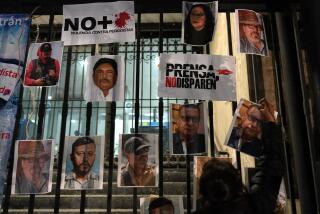‘Midnight Family’ documents Mexico’s fiercely competitive ambulance-for-hire scene
- Share via
A chance encounter on a Mexico City street took a young filmmaker on a wild detour to making one of 2019’s most thrilling documentaries, which gives the notion of “ambulance chasing” a whole new meaning.
In “Midnight Family,” which made the Academy Award shortlist for documentary feature, audiences meet the Ochoas — primarily father Fer, his teenage son and driver Juan, and younger son Josué, not yet an adolescent — who run one of the city’s fiercely competitive ambulance-for-hire services. These private operations fulfill an urgent need: The city’s 9 million residents are served only by some 45 state-owned ambulances. Each night, the Ochoas race through the neon-drenched streets of one of the world’s most densely populated cities, using a scanner to monitor police reports as they gun hard to reach accident victims — and other prospective clients — before another service gets there.
Luke Lorentzen was 23 and new to Mexico City, where he was frustrated trying to assemble a different project. One day in December 2015 he came upon the Ochoas’ ambulance, parked in front of his apartment. They invited him to ride along.
“That first evening I just saw this whole underworld of for-profit health care that really shocked me,” Lorentzen said, “and made me feel a lot of different things, all while enjoying the experience of being with this family.”
The film, which won a special jury award for cinematography at the Sundance Film Festival and the grand jury award at England’s Sheffield Doc/Fest, immerses audiences in that experience, putting them behind the wheel of the Ochoas’ cramped emergency vehicle. The compact space heightens the visceral situations the family encounters — as they collect bloodied and emotionally distraught patients — and the sometimes eccentric dynamics among its members.
Lorentzen, who rode with and filmed the Ochoas until early 2018, found the excitement (and existential moodiness) of the nightly runs could be captured with minimal tools. He worked as a one-man crew, with one camera strapped to the ambulance’s hood and another in his hands. The filmmaker built confidence over a long series of rides, working limitations — a single 24mm lens, the tight space inside the vehicle — to his advantage.
Documentary “Midnight Family” follows a private ambulance service on an exhilarating rise through the streets of Mexico City.
The nocturnal shoots also provide a glimpse of an urban wonderland most people don’t see. “I was so excited about just how beautiful and alluring Mexico City is at night,” he said. “There’s so many different neon colors.” Lorentzen said he was as likely to think of the visual compositions of the late Austrian documentarian Michael Glawogger (“Whore’s Glory,” “Workingman’s Death”) as David Fincher while behind the camera, working almost entirely with available light.
He also looked to the obsessive experiential quality of documentaries out of Harvard’s Sensory Ethnography Lab, with their knack for giving moving images a tactile expressiveness. That approach gives the film’s craziest sequences a rollercoaster immediacy.
One high-speed run, in which Juan hit the pedal to brake ahead of a rival ambulance, bristles like an excerpt from “The Fast and the Furious.” Lorentzen was too wrapped up in such moments to worry much about the risks.
“I was so motivated to capture all this energy,” he said. “There were very few moments where I felt really out of control. Speeding at 80 mph through Mexico City is pretty hair-raising, but I knew those would be some of the most amazing scenes in the film.”
Such elements were much easier to convey than the often disturbing ethical questions that came into play. “The deeper I got into it, the more I realized there were these really big socio-political questions at the center of it,” said Lorentzen, whose Mexican residencies were juggled with four seasons working on Netflix’s “Last Chance U.”
“Some nights, they save somebody’s life and other nights they put people in really questionable situations,” said the filmmaker, who shows how the family must hustle the suffering, or sometimes prioritize money over mercy, to generate the income that keeps their cash-strapped enterprise in business. Everyone is trying to survive.
“That balance between good and bad was a really subtle palette of emotions, and I didn’t have the material to get that across until really late.”
Indeed, about three-quarters of the film comes from a final shooting phase with the Ochoas, right after an earlier cut of “Midnight Family” was turned down by Sundance. But when Lorentzen went back, the family trusted him enough to really make themselves vulnerable for the camera, he said. “When you think of the craft of filmmaking, the first thing everybody talks about is cinematography, editing, sound, the music.
“On this film, I spent most of my time just building this relationship. Not every documentary depends on it as much as ‘Midnight Family’ does but with this film, it’s the only piece holding everything together.”
More to Read
Only good movies
Get the Indie Focus newsletter, Mark Olsen's weekly guide to the world of cinema.
You may occasionally receive promotional content from the Los Angeles Times.










